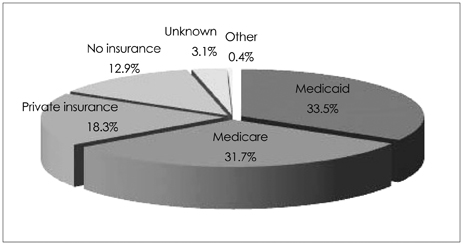J Clin Neurol.
2014 Jul;10(3):216-221. 10.3988/jcn.2014.10.3.216.
Emergency Medical Care of Multiple Sclerosis Patients: Primary Data from the Mount Sinai Resource Utilization in Multiple Sclerosis Project
- Affiliations
-
- 1Corinne Goldsmith Dickinson Center for Multiple Sclerosis, Icahn School of Medicine at Mount Sinai, New York, NY, USA. stephen.krieger@mssm.edu
- 2Department of Neurology, University Hospital of Bonn, Bonn, Germany.
- KMID: 2179448
- DOI: http://doi.org/10.3988/jcn.2014.10.3.216
Abstract
- BACKGROUND AND PURPOSE
There has been no systematic analysis of emergency department (ED) utilization in the multiple sclerosis (MS) population. We investigated the acute-care needs of MS patients using ED as a route for entry into healthcare services.
METHODS
ED visits made by MS patients were identified. Data extracted included demographics, medical/neurological history, and workup/management in the ED.
RESULTS
The Mount Sinai ED received 569 visits from 224 MS patients during a 3-year period, of whom 33.5% were covered by Medicaid and 12.9% were uninsured. Patients with an Expanded Disability Status Scale score of > or =6 accounted for 54%, 50.5% of relapsing remitting MS patients were being treated with disease-modifying therapies, and 74.5% of the ED visits were non-neurological. Patients with mild-to-moderate MS were more likely to present to the ED for issues directly related to MS such as acute exacerbations, while those with severe MS presented more often due to medical issues indirectly related to MS, such as urinary tract infections (p<0.0001).
CONCLUSIONS
Most MS patients seeking ED care suffer from acute non-neurological problems. The MS patients presenting to the ED tended to be underinsured, had high levels of disability, and were undertreated with disease-modifying therapies. The acute-care needs of MS patients evolve over the disease course, as do the resources that must be utilized in providing emergency care across the spectrum of MS severity. Understanding the characteristics, problems, and needs of MS patients utilizing the ED is an important step in improving care in this population from both clinical and public health perspectives.
MeSH Terms
Figure
Reference
-
1. Ford HL, Gerry E, Johnson M, Williams R. A prospective study of the incidence, prevalence and mortality of multiple sclerosis in Leeds. J Neurol. 2002; 249:260–265.
Article2. Runmarker B, Andersen O. Prognostic factors in a multiple sclerosis incidence cohort with twenty-five years of follow-up. Brain. 1993; 116(Pt 1):117–134.
Article3. O'Brien JA, Ward AJ, Patrick AR, Caro J. Cost of managing an episode of relapse in multiple sclerosis in the United States. BMC Health Serv Res. 2003; 3(1):17.4. Icahn School of Medicine at Mount Sinai. Mount Sinai Data Warehouse [Internet]. New York: Icahn School of Medicine at Mount Sinai;2004. cited 2014 Jan 16. Available from: http://icahn.mssm.edu/about-us/services-and-resources/computer-services/resources/research-information-technology/mount-sinai-data-warehouse.5. DeNavas-Wait C, Proctor BD, Smith JC. Current Population Reports, P60-235, Income, Poverty, and Health Insurance Coverage in the United States: 2007. Washington, DC: U.S. Government Printing Office;2008.6. Mutiple Sclerosis dataBase. Baseline Characteristics [Internet]. Parkville: Mutiple Sclerosis dataBase;2014. cited 2014 Jan 16. Available from: www.msbase.org/msbase/cms/benchmarking.json.7. Lacy JR, Stuart WH, Jacobs LD, Vartanian T, Phillips JT, Greenstein JI. Registry of Multiple Sclerosis Treatment and Care (MSTRAC) Patient and Physician Characteristics. Int J MS Care. 2000; 2:25–36.
Article8. O'Brien GM, Stein MD, Zierler S, Shapiro M, O'Sullivan P, Woolard R. Use of the ED as a regular source of care: associated factors beyond lack of health insurance. Ann Emerg Med. 1997; 30:286–291.9. Marrie R, Horwitz R, Cutter G, Tyry T, Campagnolo D, Vollmer T. Comorbidity, socioeconomic status and multiple sclerosis. Mult Scler. 2008; 14:1091–1098.
Article10. Stettler BA, Jauch EC, Kissela B, Lindsell CJ. Neurologic education in emergency medicine training programs. Acad Emerg Med. 2005; 12:909–911.
Article11. Telfair J, Haque A, Etienne M, Tang S, Strasser S. Rural/urban differences in access to and utilization of services among people in Alabama with sickle cell disease. Public Health Rep. 2003; 118:27–36.
Article12. Buchanan RJ, Stuifbergen A, Chakravorty BJ, Wang S, Zhu L, Kim M. Urban/rural differences in access and barriers to health care for people with multiple sclerosis. J Health Hum Serv Adm. 2006; 29:360–375.
- Full Text Links
- Actions
-
Cited
- CITED
-
- Close
- Share
- Similar articles
-
- Primary Sjogren's syndrome manifested as multiple sclerosis and cutaneous erythematous lesions: a case report
- Analgesia for Labor in a Parturient with Multiple Sclerosis: A case report
- Reduction of Disease Activity in Patient with Relapsing-Remitting Multiple Sclerosis after Switching to Teriflunomide from Interferon Beta
- A Case of Multiple Sclerosis in Child Showing Homonymous Hemianopia
- A Case of Unilateral Renal Angiomyolipoma Associated with Tuberous Sclerosis




